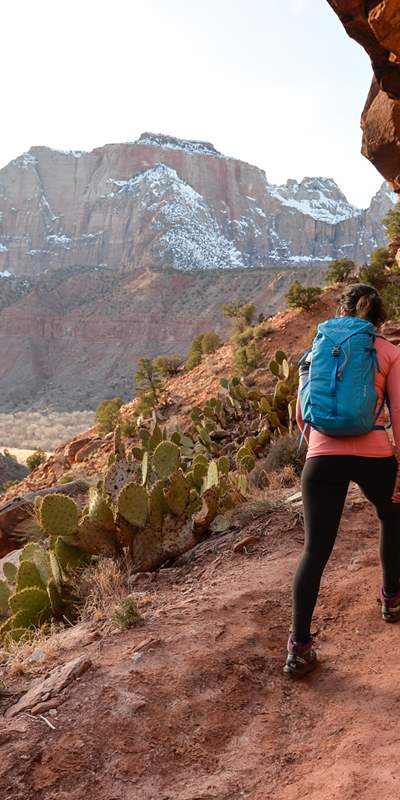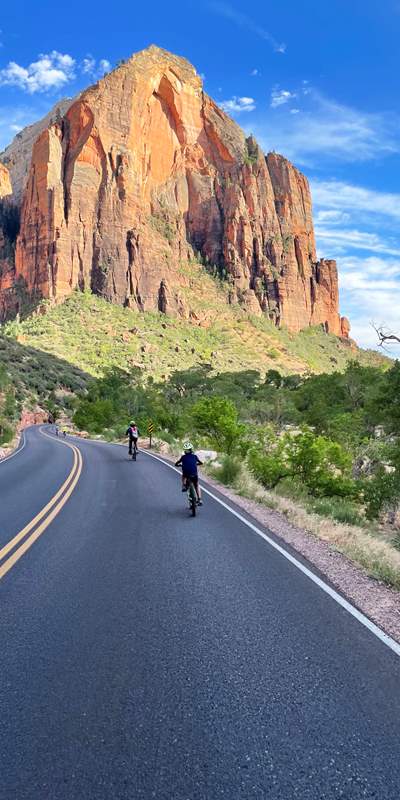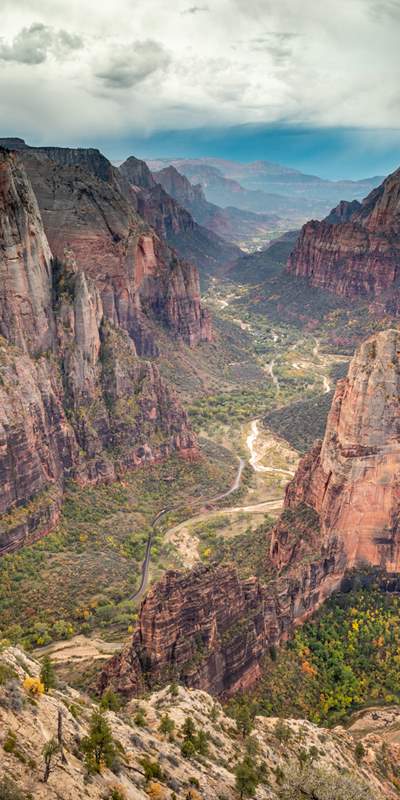
Canyoneering
From above, Zion looks like a picture of fractured red rock expanse, split by a network of narrow slot canyons. These canyons have become some of the most sought-after destinations in the country for canyoneers, with routes available for any ability level. Descending the park’s narrow canyons is a serious endeavor that often involves rappelling, swimming, navigational skills, and some climbing; but for the thrill-seeker, canyoneering in Zion National Park may just be the experience of a lifetime.
To get started, you’ll want to contact a local guide. Canyoneering requires a permit, specialized gear, and familiarity with the area; all of which can be provided on a guided trip. Start by learning the foundational techniques, then head into the park with your guide and explore some of Utah’s greatest routes like The Narrows and Orderville Canyon.
Rock Climbing
Anybody who has ever stood beneath a sheer rock wall in Zion National Park and gazed up at a climber scaling the heights like a lizard has felt the tug of curiosity: What would it be like to do that? Could I do that?
The answer is yes.
Make no mistake, Zion National Park is a true adventure climbing arena. The big walls are serious endeavors, and the bushwhacking approaches through inhospitable terrain are legendary.
But you don’t need to get that extreme to get a taste of what rock climbing is all about. Several companies in Springdale can introduce you to rock climbing in areas just outside the park (guided climbs are not allowed inside the park). For example, Zion Mountain School and Zion Adventure Company offer a full range of lessons and guided climbs for people with zero experience — even for kids as young as six. Utah Adventure Center offers an Above Zion Via Ferrata near Kolob Terrace for guests as young as eight.

Stargazing and Night Photography
After the sun sets and the orange glow leaves Zion’s canyon walls, the park falls under a dark sky of endless stars. Zion is certified as an International Dark Sky Park by the International Dark-Sky Association, and many visitors may gaze into the night sky here to find more stars than they’ve ever seen. When you enter the park, you leave the ambient light of everyday life, making every detail of the night sky more visible.
If you can, plan some time during your trip to see Zion’s dark skies. The park gets dark at night, so be sure to pack some form of lighting and warm clothes and stay off the roads. The campgrounds are a great place for stargazing, along with the park’s various viewpoints. (Read: "How to Stargaze in Utah")
Scenic Driving
It’s unnecessary to venture off the road to experience the wonders of Zion National Park. Zion Canyon National Scenic Drive is a beautiful road that follows the North Fork of the Virgin River upstream from Canyon Junction through some of Zion’s most outstanding scenery. This road is closed to private vehicle traffic in the summer and fall, but regularly scheduled shuttle buses provide a great way to relax and enjoy the scenery, or stop to take a hike and then catch a later bus back down the canyon.
The Zion Park National Scenic Byway (54 miles one way) follows Highway 9 from its western terminus at exit 16 on I-15 to its eastern junction with U.S. 89 at Mount Carmel Junction. The road east from Zion to Mount Carmel Junction, completed in 1930, was considered one of the great road-building accomplishments in history at the time. As you climb switchbacks from the canyon floor to the two high plateaus to the east, passing through two narrow tunnels blasted through the cliffs, you will understand why it created such a sensation.
The Kolob Fingers Road Scenic Byway (5 miles one way) in the northwestern corner of Zion National Park features the same dramatic desert landscape associated with the main section of the park: towering colored cliffs, narrow winding canyons, forested plateaus and wooded trails along twisting side canyons. What you probably will not find here are the crowds of visitors, so this is a great place to explore if you are seeking solitude.

Horseback Riding
The only guided horseback rides available within the park are provided by Canyon Trail Rides, an outfitter partnered with the National Park Service. They offer guided horseback rides of one or three hours. The one-hour ride is a relaxing journey along the Virgin River, while the 3-hour ride is a more adventurous trek up the Sandbench Trail with great park views.
Biking and E-biking
Although mountain biking is not permitted within the park's boundaries, bicycles — including e-bikes — are allowed on the paved road in Zion Canyon, making them a great option for transportation from trail to trail. Riding through Zion Canyon on two wheels is a truly immersive experience. You can feel the wind in your hair and the sun on your face as you pedal along the Virgin River. The enormous sandstone cliffs and colorful rock formations surround you, and you feel like you're in a different world. Biking is a more flexible alternative to riding the shuttle, as you can move from trail to trail at your own pace without closely watching the time or waiting in any lines.
River Rafting
For experienced paddlers, the Virgin River in Zion National Park offers a challenging yet rewarding overnight adventure complete with breathtaking vistas that provide an intimate experience with Zion’s wilderness. A free wilderness permit, available at the Zion Canyon Visitor Center, is mandatory for all river trips. If you're an expert aiming to raft through The Narrows section of the river, secure your permit a day in advance and be prepared for Class V whitewater conditions. The Virgin River is not a beginner-friendly river trip, but experienced rafters can prepare by learning more on the National Park Service website.Birding and Wildlife Watching
With more than 200 species of birds, Zion National Park is a birder’s paradise. The Peregrine falcon, the bald eagle, and the California condor are all found in the 232 square mile sanctuary of Zion, nesting and resting in their native habitat without being disturbed. The threatened Mexican spotted owl also calls Zion home.
Zion National Park is an official global and state IBA (Important Bird Area), and Zion has been an important part of the recovery effort for the majestic Peregrine falcon, a species that was almost lost from the United States in the 1970s due to the use of DDT and other pesticides.
The park bird list is available at the visitor centers. So grab your best pair of binoculars and start looking toward the sky! Who knows what birds you might see and check off your life list? And while searching for birds, take time to observe other flora and fauna while walking along the trail, including the more than 1,000 plant species found in Zion as well as dozens of species of mammals, reptiles and amphibians — even fish! Learn more about nature and wildlife at Zion National Park.
Things to Know Before You Visit Zion National Park
Choose the Right Time to Visit
Many consider fall the best time to visit Zion National Park. The weather is mild (highs around 60 to 70 degrees Fahrenheit) and the park foliage begins to change color bringing vibrant splashes of color that perfectly complement Zion’s towering red cliffs and tranquil streams. However, winter in Zion National Park offers visitors the most solitude and tranquility.
Pay the Entrance Fee
The National Park Service charges a fee for entry into Zion; the money collected is used to maintain Zion and other National Parks. The cost of admission is based on the mode of transportation used to enter the park, with varying prices for private vehicles, motorcycles and pedestrians. Visitors can also consider purchasing an America the Beautiful - National Parks and Federal Recreation Lands Pass, which grants unlimited annual access to all lands managed by the National Park Service.
Take the Shuttle
Apply for Permits
Many attractions in Zion National Park require a permit to be obtained in advance. Visitors interested in hiking Angels Landing, rafting on one of the rivers, canyoneering in the park, or camping overnight in Zion’s wilderness will have to secure a permit beforehand on the National Park Service website. Some permits, such as the Angel's Landing permit, are highly sought-after; start planning your trip by researching how and when to book your permit through the NPS website.
Plan Your Meals: Restaurants in the Park and Springdale
Dining options within the park are limited. The Zion Lodge, located midway up Zion Canyon Scenic Drive, offers a dining room with breakfast, lunch and dinner service, and a café-style snack bar. Outside of these few options within the park, visitors must turn to the gateway town of Springdale for additional dining experiences.
Springdale is a small town with a big culinary scene. You'd be surprised to find such a wide variety of great restaurants in this unassuming town. From casual eateries to fine dining experiences, there's something for everyone in Springdale. And with its proximity to Zion National Park, it's the perfect place to refuel after a day of hiking or exploring.
Walk Your Pets On Paved Trails Only
Zion is generally not pet-friendly. Pets are not allowed on any of the trails in Zion Canyon except The Pa’rus Trail, a flat, paved trail that sprawls across the canyon floor. The scenery on this trail is still world-class — offering panoramic views of Zion’s expansive, breathtaking rolling fields set against its sky-scraping orange spires. But you cannot take your pets to famous destinations deeper in the park such as The Emerald Pools, Angel’s Landing or The Narrows.







